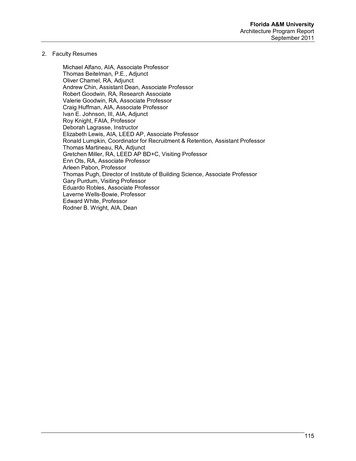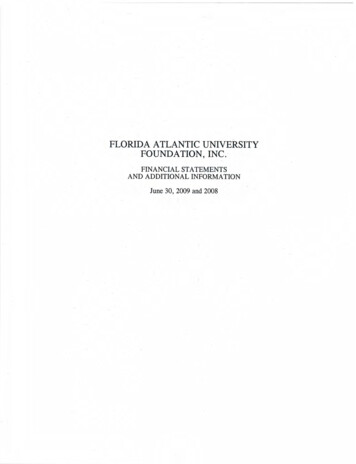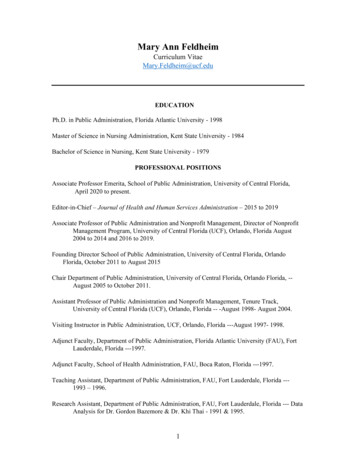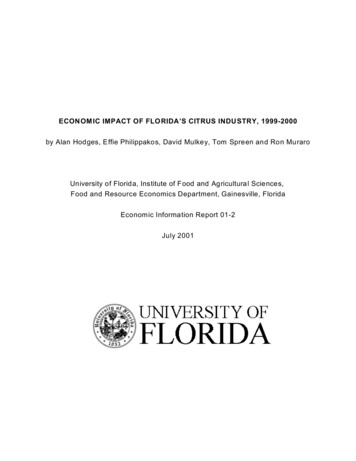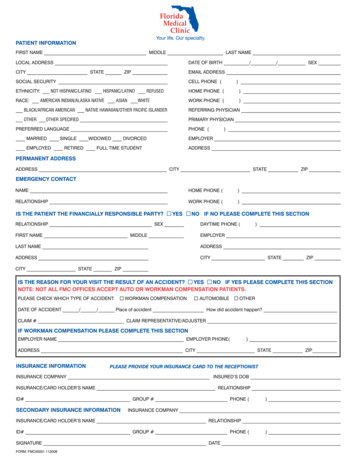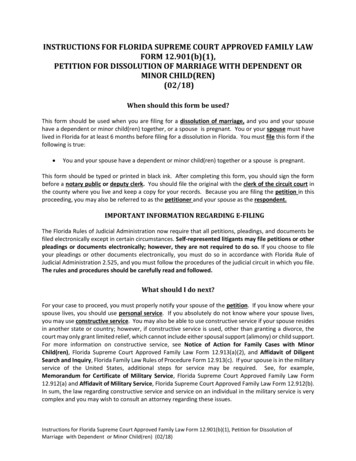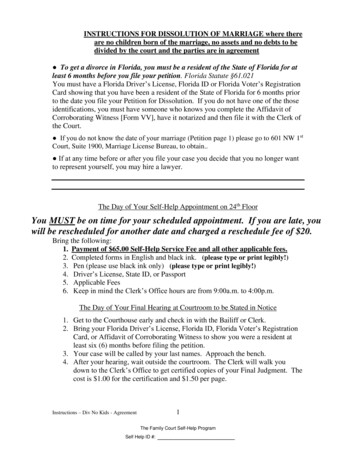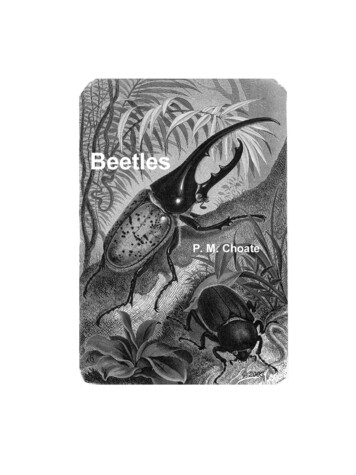
Transcription
2003
Identification of Beetles (Coleoptera)Notes:There have been many name changes within the Order Coleoptera. Numerous families have been split,and some have been combined. Familys names listed here are those used in your textbook. When a textbookrevision is published in 2004 the new family names will be used. Until then, please use the names as theyare presented in your text.
Dichotomous Keys to Some Families of Florida ColeopteraIntroduction to the Identification of Beetles (Coleoptera)P. M. Choate, 2003The order Coleoptera probably contains the largest number of described species of any insect order.Beetles are found in almost every habitat, and rangein size from 1 – 100mm. in length. The heaviestknown insect is a scarab beetle.The diversity of this order contributes to the complexity of writing classification keys that encompassall exceptions. Frequently generic keys that are written to cover all species become so complex andlengthy that even experts get bogged down in details. In order to introduce you to this order withoutadding to the difficulty of identification I have constucted a key to 50 families of beetles that youshould be able to identify (Florida). Keep in mindthat there are more than 100 families of beetles, andthat this key is only intended to introduce you to theterminology and morphology that you will use in other, more comprehensive keys.The keys that follow are dichotomous, meaning that each couplet has 2 paragraphs of charactersfrom which you are to pick the best match. Throughprocess of elimination you should be able to workyour way through this key to a reasonable identification choice. If you find that every couplet seems tobe a difficult choice, you have likely made a mistakeor the specimen you are trying to identify belongs ina family not included in the key. When you arrive ata tentative identification, look at examples of thefamily to see if you have a specimen that fits members of that family. Realize that some of the largerfamilies have many different morpho-types, so becautious here!Terminology: Beetle identification requires youto become familiar with antennal shapes, tarsi (formulas, shapes of segments) mouthparts (labial andmaxillary palpi), ventral characters (sterna, pleura, coxae), and other morphological characters. Sizeand color of specimens will not usually help you identify beetle families unless you are already familiarwith the morphological characters that identify eachfamily. Therefore, do not try to remember familiesfrom pictures or by size and color. There is too muchvariation. Learn the morphology that sets each family apart. Family names have undergone numerouschanges with the publication of American Beetles(Arnett and Thomas,2001) vols. 1 and 2. I follow traditional family names here (sensu Borror, Triplehorn,and Johnson)Suborder AdephagaCarabidae - ground beetles, includes Rhysodidaeand CicindelidaeCicindelidae - tiger beetles now treated as Carabidae, tribe CicindeliniRhysodidae - now placed in CarabidaeHaliplidae - aquaticNoteridae - aquaticDytiscidae - aquaticGyrinidae - aquatic, surface inhabitants onlySuborder PolyphagaStaphylinidae - rove beetles, elytra reduced, exposing several abdominal tergitesSilphidae - carrion beetlesPselaphidae - short-winged beetles (very small, 3mm).Hydrophilidae - mostly aquatic, maxillary palpi appear as antennae when viewed from above, antennae shorter than palpi, with well developedclub.Histeridae - clubbed antennae, many species veryconvex and capable of retracting legs into grooves.Scirtidae - ( Helodidae) small ( 7mm), pubescentspecies, with swollen femora for jumping.Lucanidae - stag beetles; antennae elbowed, largebeetles ( 20mm.) 3 genera in Florida, found inpanhandle only.Passalidae - Large shining black beetles, adults andlarvae occur in colonies in rotting logs. Both sexeswith hornsScarabaeidae - "June", "dung", flower inhabitingbeetles. One of the largest families of Coleoptera.Lamellate antennae, size quite variable.Buprestidae - metallic wood borers. Closely resemble click beetles but lack clicking mechanism Manyspecies brightly colored or at least with metallicreflection.Callirhipidae - ( Rhipiceridae)Elmidae - aquaticDryopidae - aquaticHeteroceridae - semi-aquaticPtilodactylidae - unusual antennal shapes in malesof some speciesElateridae - click beetlesEucnemidae - false click beetlesCebrionidae - males fly when its raining, femalesare brachypterous.Lycidae - net winged beetles
Identification of Beetles (Coleoptera)Phengodiae - glow worms; males fly, female larviformLampyridae - firefliesCantharidae - soldier beetlesDermestidae - skin beetlesBostrichidaeAnobiidae - death watch ujidae - flat bark beetlesLanguriidae - lizard beetlesCoccinellidae - lady bugsEndomychidae - pleasing fungus beetlesMelandryidae - false darkling beetlesAnthicidae - ant-like flower beetlesTenebrionidae - darkling beetles, frequently misidentified as ground beetles by beginning students.Mordellidae - Tumbling flower beetlesMeloidae - blister beetlesRhipiphoridae Lagriidae Cerambycidae - "long horned beetles"Bruchidae - seed weevilsChrysomelidae - leaf beetles, with 4 distinctly different body shapes.Curculionidae - e - bark beetlesGreat Plains.Edwards Brothers, Inc. Ann Arbor,Michigan.181p.Peck, S. B., and M.C. Thomas. A distributional checklistof the beetles (Coleoptera) of Florida. Arthropods ofFlorida and neighboring land areas. Vol. 16. Entomology Contribution no. 862.Florida Dept. Agric. and Consumer Services, Gainesville, FL. 180pp.Young, F. N. 1954. The water beetles of Florida. University of Florida Press, Gainesville. 238p.Coleoptera: sub-order Adephaga orPolyphaga?These 2 sub-orders are based on the positions ofthe hind coxal cavities in relation to the 1st visiblesternite. If the hind coxae are fused to, and dividethe 1st visible abdominal sternite (Figs. 1, 4), thespecimen belongs in Adephaga. If hind coxae areon a flexible plate and do not completely divide the1st visible sternite (Fig. 2), the specimen belongs inPolyphaga.Once you are satisfied that you have correctlyplaced the specimen into its correct sub-order, proceed to the next level of keys (to family).1st visible sterniteHind (meta-) CoxaIn order to identify these families you must firstbe able to separate them into 2 major suborders(Adephaga and Polyphaga). Beetle family keysand checklists are numerous, frequently regional,and rarely comprehensive. A few of the more comprehensive are:ReferencesArnett, R. H., Jr. 1960 - 1963. The beetles of the UnitedStates. Washington, DC. Catholic University Press. xii 1110p.(includes keys to all of the genera for all families in USA).Arnett, R. H., Jr., and M. C. Thomas. 2001. AmericanBeetles. vol. 1. Archostemata, Myxophaga, Adephaga,Polyphaga: Staphyliniformia. CRC Press, Boca Raton,FL.443p.Blatchley, W. S. 1910. An illustrated Descriptive Catalogue of the Coleoptera or beetles known to occur inIndiana. Indianapolis. 1386p.Downie, N. M., and R. H. Arnett.1996. The beetles ofNortheastern North America. Vol. 1: Introduction; Suborders Archostemata, Adephaga, and Polyphaga, thrusuperfamily Cantharoidea. The Sand Hill Crane Press,Gainesville, Florida.880p.(includes species keys for allfamilies).Edwards, J. G.1949. Coleoptera or Beetles East of theFig. 1. Adephaga - coxa divides 1st visible sterniteHind (meta-) coxaEpimeron1st visible sterniteFig. 2. Polyphaga - coxa does not divide 1st sternite; besure not to confuse the epimeron with the coxae.
Dichotomous Keys to Some Families of Florida . 3. Dorsal view of Adephaga beetle, Carabidae. Tarsalformula 5-5-5. Antennae filiform.A few reasons why we can't generalize aboutbeetle families:procoxamesocoxametacoxasterna 1-6Fig. 4. Ventral view of Adephaga beetle, Carabidae.– There are many long-horned beetles that donot have long horns.– There are snout beetles without snouts.– There are beetles with snouts that are not weevils.– There are "June beetles" that appear in August.– There are ground beetles that live in trees.– There are aquatic beetles that never go nearwater (some Hydrophilidae live in dung).– There are ectoparasitic beetles.– Many beetles have fused elytra, with flightwings reduced to small pads.– There are blind, eyeless subterranean beetles.– There are beetles other than fireflies (Lampyridae) that produce light.– The same family may have species that rangein size from 1mm to 100mm.– The same genus may have brightly colored species as well as dull, uniformly colored species.– The are many volumes of literature dealingwith the classification of beetles, but rarely do theyagree on higher classification.We will introduce you to the diversity of beetles,while emphasizing that this diversity will initiallymake it seem difficult to become familiar with thesefamilies.Once you have made a tentative identification, be sure to check your textbook for comparison.Since it is impractical to include all families here,we have chosen to create a key for the more commonly collected families. Keep this in mind when youare identifiying specimens.
Identification of Beetles (Coleoptera)Key to some Florida families ofColeoptera: s.o. Adephaga1. Hind coxae greatly enlarged, forming a plate thatcovers attachment of hind legs. Body size 3mm.,pale with dark spots (Fig. 5) . Haliplidae– Hind coxae not greatly enlarged into plates. Sizeand color various . 22. Eyes divided into 2 portions by lateral margin ofhead; one dorsal and one ventral when viewedfrom the side (Fig. 6). Body dorsally flattened.Antennae reduced to short peg-like structures.Whirligig beetles . Gyrinidae– Eyes not divided by lateral margin of head. Antennae variously shaped . 33. Hind legs modified for swimming, posterior margin with fringes of hairs (Fig. 7. Antennae longand moniliform or filiform . 4– Legs not modified for swimming. Antennae moniliform Carabidae (Figs. 3, 4) (including Cicindelidini, Rhysodini) *keys to Florida ground ida carabidae new.pdfcoxal plateFig. 5. Adult Haliplidae. Left - ventral aspect showingcoxal plates; right - dorsal aspect.dorsal part of eyeventral part of eyeFig. 6. Side view of Gyrinidae head. Eyes are split into 2sections.4. Scutellum visible(Fig. 8c) Dytiscidae (in part)– Scutellum hidden (Figs. 8 a, b) . 55. Hind tarsi with 2 curved claws (Fig. 9) of equallength; abdomen with 5 visible sterna; front coxal cavities closed behind (small beetles, 1-5mm). Noteridae– Hind tarsi with 1 straight claw; abdomen with 6visible sterna; front coxal cavities open behind;size usually over 5mm . Dytiscidae (in part)fringes of hair alongposterior marginFig. 7. Hind leg of Dytiscidae showing fringed posteriormargin.scutelluma.b.c.Fig. 8. Adult Dytiscidae and Noteridae. Note scutellumthat is visible in many Dytiscidae (c.).2 tarsal clawsFig. 9. Adult Noteridae. Note 5 visible sterna, 2 claws onhind tarsi. Superficially similar in shape to Dytiscidae,their small size ( 5mm) and above characters shouldmake them fairly easy to identify.
Dichotomous Keys to Some Families of Florida ColeopteraKey to some Florida families ofPolyphaga Coleoptera1. Abdomen with at least 3 segments corneous (chitinous) dorsally; 1 or more segments exposed byshortened elytra (Fig. 11). Antennae variable,but never lamellate (Fig. 10) . 2– Abdomen at most with 2 segments corneous dorsally; elytra completely covering abdomen . 5Fig. 10. Lamellate antenna, scarab genus Polyphylla.2. Elytra very short, dorsally exposing 4-7 abdominal segments . 3–Elytra covering most of abdomen, dorsally exposing 1-2 segments . 43. Abdomen flexible, with 7 or 8 segments visibleventrally; antennae not clubbed distally . Staphylinidae– Abdomen not flexible, only 5 or 6 ventral segmentsvisible (Fig. 11); antennae with distal segmentsenlarged, may form a club .Pselaphidae, Nitidulidae with shortenedelytra4. Hind tarsi 5 segmented, antennae elbowed andclavate (Fig. 12a.) . Histeridae– Hind tarsi 5 segmented, middle and front tarsi 5segments; antennae not elbowed (Fig. 12b) . SilphidaeFig. 11. Dorsal view of Pselaphidae.12a.12b.Fig. 12. a. Antenna of Histeridae; b. Silphidaehorn5. Antennae with lamellate club (Fig. 10) . 6– Antennae variable but not with lamellate club . 86. Plates composing antennal club flattened and capable of close apposition . Scarabaeidae– Plates of antennal club not capable of closing, andnot flattened . 77. Large black shining beetles; antennae curved;both sexes with short curved horn (Fig. 13) onhead; elytra deeply striated . Passalidae– Large, dull beetles ( 20mm); Antennae elbowed(Fig. 14); head without horns; in species withbrown coloration, elytra smooth and not striated; if black species, elytra dull and unevenly carinate or shallowly striate . Lucanidae8. All tarsi apparently 4 segmented; 1st 3 segmentsdilated and brush-like beneath; or 3rd segmentdeeply bi-lobed (Fig. 15) . 9– Tarsi variable; one or more pair with 3, or 5 segments; if segment bi-lobed, usually 2nd or 4thsegment . 179. Head not prolonged into beak . 10Fig. 13. Head of Passalidae.Fig. 14. Geniculate antenna of Lucanidaesegment 1Fig. 15. Tarsus of Chrysomelidae. Apparently 4 segmented,with pads beneath each segment. Segment 3 deeply bilobed.
Identification of Beetles (Coleoptera)– Head prolonged into beak (Figs. 16, 17, 18) whichmay be short and inconspicuous . 1310. Antennae filiform or nearly so . 11– Antennae distinctly clavate . Erotylidae11. Oval, compact beetles; antennae and body usually with scales;elytra shortened, exposing pygidium; antennae serrate, rarely pectinate; headprolonged into broad "muzzle" . Bruchidae– If oval, not with above combination of characters. 1212. Body elongate; antennae frequently longer thanbody, inserted on frontal prominence; pronotumunmargined; tibial spurs well developed; . Cerambycidae– Body shape various, rarely elongate; Antennaemoderate, not longer than body; not inserted onfrontal prominence; prothorax frequently margined; tibial spurs absent; . Chrysomelidae13. Beak extremely short and broad; tibiae with series of teeth externally or front tibiae anteriorlyproduced forming stout curved process at apex;antennae short with broad club; small, oval orcylindrical beetles . 14– Beak conspicuous, frequently elongate (Fig. 16);tibiae simple, without teeth externally or at apex;antennae clubbed or not . 15elongate 1st antennal segmentsnoutFig. 16. Lateral view of head of typical weevil14. First segment of anterior tarsi shorter than 2nd,third, and 4th combined; eyes oval, emarginate,or divided; head narrower than thorax . Scolytidae– First segment of anterior tarsi very long, longerthan 2 3 4 combined; eyes round; head broaderthan prothorax . Platypodidae15. Antennae straight, without distinct club; beakpresent at least in female and pointing directlyforward (Figs. 17, 18); body shape elongate andnarrow . Brentidae– Antennae straight or geniculate, always with a distinct club . 1616. Palpi flexible; beak short and broad; thorax withtransverse raised line which is ante-basal or basal; antennae long, with small but distinct apicalclub; . Anthribidae– Palpi rigid; beak well developed, frequently longand downward curved; . Curculionidae17. Hind tarsi clearly 5 segmented . 18–Hind tarsi apparently 3 or 4 segmented . 38Fig. 17 Female BrentidaeFig. 18. Male Brentidaeantennamaxillary palpussternal spineFig. 19. Ventral view of Hydrophilidae beetle.
Dichotomous Keys to Some Families of Florida Coleoptera18. Maxillary palpi as long as or longer than antennae. (Fig. 19) Antennae with terminal 3-4 segments forming a distinct club. Many species withelongate sternal spine . Hydrophilidae– Palpi length "normal". If sternum spined, it is confined to prosternum only . 1919. Tarsal claws elongate, large; abdominal segments1-3 fused ventrally (Fig. 20) . 20– Tarsal claws normal . 21enlarged tarsal clawsFig. 20. Dryopidae tarsal claws20. Anterior coxae transverse, with distinct trochantin . Dryopidae– Anterior coxae rounded, lacking trochantin . Elmidae21. Abdomen with no more than 5 segments . 22– Abdomen with at least 6 segments . 3422. Hind femur joined at apex of trochanter . 23– Hind femur joined to side of trochanter . 2523. Tibia without spines . Anobiidae– Tibia with spines . 2424. Ventral segment 1 (sternum) more or less equalto sternum 2 . Bostrichidae– Ventral segment 1 elongate, longer than segment2 . Lyctidae25. Anterior coxae globular or transverse, projectingbut little from coxal cavity . 26– Anterior coxae conical, projecting prominently fromcoxal cavity . 3226. Anterior coxae transverse . 27– Anterior coxae globular . 2827. Tarsi more or less dilated; segment 1 not shorter; antennae 11 segmented, terminating in a 3segmented club . Nitidulidae– Tarsi slender, 1st segment short, antennae withapical segments expanded into pseudo-club . Trogossitidae28. Prosternum with posterior process extendingbackwards into a groove in mesosternum (Fig.21 ) . 29– Prosternum without process received by the mesosternum, although it may be prolonged so asto meet mesosternum . 3129. Abdominal segments 1 2 fused on ventral side. Buprestidae– All abdominal segments free on ventral side . 30Prosternal processFig. 21. Prosternal process extending back intomesosternum.
Identification of Beetles (Coleoptera)30. Prothorax loosely joined to mesothorax; front coxal cavities ending in prosternum; antennae inserted distant from eyes, insertion narrowing thefront . Eucnemidae– Prothorax firmly joined to mesothorax; antennaeinserted under margin of front . ElateridaeFig. 22. Antenna of Zenoa picea, Callirhipidae.31. Body flattened, depressed (size generally small,less than 5mm for most species); middle coxalcavities not closed externally by a meeting ofmesosternum and metasternum . Cucujidae– Body convex; middle coxal cavities entirely surrounded by sterna . Erotylidae32. Posterior coxae dilated into plates partly protecting femora, at least at their sides . 33– Posterior coxae not dilated into plates partly protecting femora; Posterior coxae flat, not prominent, covered by femora in repose; tarsi with 4thsegment of normal size . Cleridae33. Antennae serrate or flabellate (Fig. 22 ) . Callirhipidae ( Rhipiceridae)– Antennae with last 3 segments forming a distinctclub; tarsi simple . DermestidaeFig. 23. Lycidae, showing reticulated elytral sculpturing.34. Anterior coxae globular; tibial spines well developed . Cebrionidae– Anterior coxae conical . 3535. Middle coxae contiguous; epipleura distinct . 36– Middle coxae distant; epipleurae lacking; elytrareticulated (Fig. 23) . Lycidaereticulated surface36. Episterna of metathorax not sinuate on innerside; epipleura usually wide at base . 37– Episterna of metathorax sinuate on inner side;epipleura narrow at base . Cantharidae37. Head more or less covered by pronotum whenviewed from above; antennae approximate ormoderately distant (they almost touch atbase);metathorax epimeron long; many specieswith glowing organ . Lampyridae– Head exposed when viewed from above; antennaedistant; metathorx epimera wide; male antennae fimbriate (Fig. 24) . Phengodidae38. Hind tarsi clearly with 3 segments; or 4 segmented, with 3rd segment small and concealed in anotch at end of 2nd segment (Fig. 15); or all tarsi with 4 segments (Fig. 25) . 39–Front and middle tarsi with 5 segments; hind tarsiwith 4 distinct and unconcealed segments . 45Fig. 24. Phengodidae male showing fimbriate antennae.Fig. 25. Hind tarsus of Heteroceridae.
Dichotomous Keys to Some Families of Florida ColeopteraDilated tibia, fitted fordigging39. All tarsi clearly 4 segmented (Fig. 25) . 40– Hind tarsi appearing to have 3 segments . 4340. First 4 abdominal segments fused on venter; tibiae dilated, armed with rows of spines, fitted fordigging (Fig. 26 ) . Heteroceridae– Ventral segments not fused . 4141. Tarsi slender; tibiae not armed with rows of spines. Endomychidae– Tarsi dilated, spongy beneath . 4242. Frontal coxal cavities closed behind by epimeron(Fig. 27); pronotum with or without moderateprebasal impressions; body elongate oval . Erotylidae– Frontal coxal cavities open behind; pronotum without distinct, paired prebasal impressions; bodyelongate, slender . Languriidae43.Tarsi with 2nd segment dilated . 44– Tarsal claws simple; elytra truncate; first and fifthabdominal segments longer than others . Nitidulidae44. Tarsal claws toothed or appendiculate (Fig. 28);first ventral segment with distinct curved coxallines . Coccinellidae– Tarsal claws simple; first ventral segment withoutcoxal lines . Endomychidae45.Anterior coxal cavities closed behind (Fig. 27) . 46– Anterior coxal cavities open behind (Fig. 27) . 4746. Tarsal claws simple; front of head with protruding rim extending from eye to eye, hiding antennal insertion when viewed from above . Tenebrionidae– Tarsal claws pectinate (Fig. 29 ) . Alleculidae47. Head not suddenly and strongly constricted atbase . 48– Head strongly constricted at base . 5048. Middle coxae very prominent . Oedemeridae– Middle coxae not very prominent . 4949. Metasternum long; epimera of metathorax visible . Melandryidae– Metasternum quadrate; epimera of metathoraxcovered . Cucujidae50.Prothorax with side pieces not separated frompronotum by a suture . 51Fig. 26. Dorsal view of Heteroceridae.openclosedFig. 27. Open behind and closed behind anterior coxalcavities.Fig. 28. Toothed tarsal claw, Coccinellidae.pectinate clawFig. 29 Tarsal claw, Alleculidae.
Identification of Beetles (Coleoptera)– Lateral suture of prothorax distinct; base of prothorax as wide as elytra. 5651. Prothorax at base as wide as elytra . Rhipiphoridae– Prothorax at base narrower than elytra . 5252. Hind coxae not prominent . 53– Hind coxae large, prominent; tarsal claws cleft ortoothed . Meloidae53. Anterior coxae globular, not prominent . Cucujidae– Anterior coxae conical, prominent . 5454. Abdomen consisting of 5 free segments, tarsi withpenultimate segment lobed beneath . 55– Abdomen consisting of 4 free segments, the firstformed from 2 fused segments; tarsi with antepenultimate segment lobed beneath . Euglenidae55. Eyes large, oval, finely faceted . Pedilidae– Eyes small, coarsely faceted . Anthicidae56. Antennae filiform . 57– Antennae flabellate in male, subserrate in female. Rhipiphoridae57. Hind coxae plate-like . Mordellidae–Hind coxae not plate-like . Melandryidae
formula 5-5-5. Antennae filiform. Fig. 4. Ventral view of Adephaga beetle, Carabidae. mesocoxa procoxa sterna 1-6 metacoxa meta-tarsus elytron meso-tibia pro-femur A few reasons why we can't generalize about beetle families: – There are many long-horned beetles that do not h
